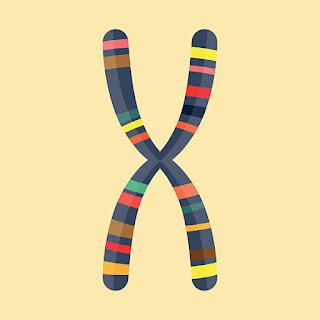Chromosomal Variations
Sometime due to somee reasons some changes OCCur in the morphology and
number of chromosomes. These changes
are Visible
phenotypically. Such changes are known as chromosomal variation.
Chromosomal variations are as followS:
1.Variation in chromosomal number
2.Variation in chromosomal morphology
1. Variation in chromosomal number:
In all living organisms the number of chromosome remain constant, but sometimes the variation in the number of chromosomes is called ploidy. It is of two types
a.Aneuploidy or Heteroploidy
b.Euploidy
a.Aneuploidy or heteroploidy:
During cell division when chromosomes are transferred into daughter cells
sometime a changes occurs in the number of chromosomes,
it is called aneuploidy or
heteroploidy.
*It is a change in the number of chromosomes, which do not involve whole set of chromosome, the change occurs in paris of a set only. In this process the chromosome
number becomes unusual and abnormal.
*Cause for Heteroploidy (Aneuploidy):
The main cause for heteroploidy is non-disjunction process. In this process the
homologous chromosomes are not separated from each or they separate abnormaly due to this the change occurs in the number of chromosomes.
Kinds of Heteroploidy(aneuploidy):
different kinds of heteroploidy:
(1) Monosomic
(2) Nullisonmic
(3) Trisomic
(4) Double trisomic
(5)Tetrasomic
(1) Monosomic:
When there is a
loss of one chromosome, it is
called monosomic. It is denoted
by (2n-1) (Monosomic).
(2) Nullisomic:
When loss
of both chromosomes of a pair,
it is called nullisomic. It is
denoted like (2n-2) (Nullisomic).
Nullisomic mostly does not survive but in Wheat plant nullisomic polypoid
(6x-2) may be survive with less fertility.
3.Trisomic:
When there is addition of one chromosome in the cell, called trisomic and denoted like (2n+1).and causes down syndrome or Monglism.
(4) Double Trisomic:
When two different chromosomes are present in triplet condition
in a diploid body, it is called Trisomic. It is denoted by 2n+1+1. this condition causes c
great genetic imbalance.
5.Tetrasomic:
When two extra chromosomes are present and denoted like (2n+2)
(ii) Euploidy
Euploidy a change in the number of chromosomes which involves whole set of
chromosomes. when an organism contains whole sets of chromosomes, it is known as
Euploid and the process is called Euploidy. In this condition the organisms contain
balanced set or sets of chromosomes.
Types of Euploidy:
The euploids may be of two types:
(1) Monoploid
(2) Polyploid
(A) Monoploid:
These organisms contain one set of chromosomes or one genome (n)
in the nuclei of heir body cells i.e. they are haploid. these organisms are mostly weak
and sterile.
Example: Datura, Sorgam, Triticum, Bees, Wasps.(ii) Euploidy
B) Polyploid:
When more than 2 sets of chromosomes(more than 2 genome) are present in organism,
called Polyploid and phenomenon is Polyploidy.it involves increase in whole set of chromosomes.
Plyploid may have many sets of chromosome, so they are of different kinds
I)Triploid)
These organisms have three sets of chromosome (3n) in their body.causes unbalanced gametes. they are not able for reproduction
Example:
Some birds,reptiles,sometimes man
Diploid (2n) + Haploid (2n)= 2n+n=3n (triploid)
(ii) Tetraploid:
Having four sets of chromosomes.
(iii) Pentaploid:
Having five sets of chromosomes.
(iv) Hexaploid:
Having six sets of chromosomes.
(v Hepta ploid:
Having 7 sets of chromosomes.
(vi) Octaploid:
Having 8 sets of chromosomes
(vii) Nanoploid:
Having 9 sets of chromosomes.
(vii)Decaploid:
Having 10 sets of chromosomes.
In wheat there are different varieties, which have 14, 28, 42 chromosome. In
Chrysanthemum also many varieties are present with 9, 18, 27, 36 & 45 pairs of
chromosome.
These are the examples of Polyploidy.
Types Of Polyploidy====> 2 typesi)Autopolyploidyii)Allopolyploidy
I)Autopolyploidy
In this the chromosomes are transferred from the same species and chromosome sets are all of same kind.
Autoploidy is common in plants like wheat,maize,rice and cotton.
Autopolyploidy are sterile and do not produce seeds.
As a result seedless fruits are produced which have great commercial value(Banana,sugarbeat,grapes
Allopolyploidy:
In this type the chromosomes are derived from two different species by hybridization, so chromosomes are of different kinds. It involves the addition
of new genomes. It occurs by the hybirdization between two species in which
doubling of chromosomes takes place.
Allopolyploidy is more common than autopolyploidy.
Example: Wheat shows allopolyploidy. It is of three kinds:
(a) With 14 chromosomes (n = 7, AA)
(b) With 28 chromosomes (n = 14, AABB, Aabb)
(c) With 42 chromosomes (n = 21, AABBCC)



Goood
ReplyDelete